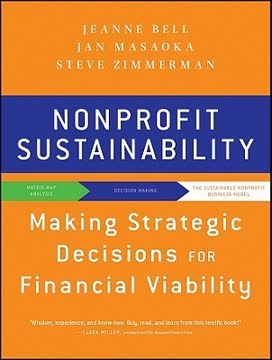Key Takeaways
1. Nonprofit Sustainability Requires a Dual Bottom Line
For nonprofits, financial sustainability and programmatic sustainability cannot be separated.
Integrated approach. True nonprofit sustainability demands an integrated view of both mission impact and financial viability. It's insufficient to have a high-impact program without a strategy for financial sustenance, just as financial stability is meaningless if it doesn't serve the organization's core mission. This dual bottom line is the bedrock of enduring relevance and effectiveness.
Financial health. Financial sustainability, in essence, means maintaining adequate working capital to ensure long-term operations. Nonprofits, despite their name, must generate surpluses—profits—to build reserves, manage cash flow disruptions, absorb mistakes, and invest in new opportunities. These surpluses are reinvested into the mission, unlike for-profit entities that distribute profits to shareholders.
Programmatic relevance. Programmatic sustainability ensures that an organization's activities remain relevant, effective, and responsive to its constituents over time. This involves developing, maturing, and, when necessary, cycling out programs to meet evolving community needs. Leaders must constantly hold both financial and programmatic objectives in mind, recognizing their deep interconnectedness in every decision.
2. The Matrix Map Visually Integrates Mission and Financial Viability
This book’s key premise is that financial and impact information can and must be brought together in an integrated, fused discussion of strategy.
Unified visual. The Matrix Map is a powerful, tested tool that provides a comprehensive and compelling visual representation of an organization's current business model. It plots each core activity—whether a program or a fundraising effort—on a two-axis grid, allowing leaders to see how all components contribute to both mission impact and financial viability simultaneously.
Mapping process. Creating a Matrix Map involves three key steps:
- Plotting: Activities are positioned on the map based on their relative profitability (horizontal axis) and mission impact (vertical axis).
- Shading: Different shades or colors can differentiate between program activities and fundraising efforts, adding another layer of insight.
- Sizing: Each activity's circle or "bubble" is sized according to its total expenses, immediately highlighting where the organization's resources are being allocated.
Strategic clarity. This visual clarity often leads to "Aha!" moments for board and staff, revealing unexpected insights about resource allocation, program effectiveness, and financial drivers. It transforms abstract financial reports and program evaluations into an easily digestible, integrated picture, fostering shared understanding and more informed strategic discussions.
3. Accurately Determine Full Costs and Revenue for Each Activity
To determine the profitability of any given business line, we need to know two things: the full costs of the business line, and the income associated with the business line.
True cost accounting. Understanding an activity's true financial contribution requires a rigorous calculation of its full costs. This goes beyond direct expenses to include a fair share of shared and administrative overhead. Underestimating these costs can lead to incorrect pricing, missed reimbursement opportunities, and a false sense of profitability.
Components of full costs:
- Direct costs: Expenses directly attributable to a specific program (e.g., staff salaries, supplies for a tree-planting program).
- Common/shared costs: Expenses incurred by multiple programs, allocated proportionally (e.g., rent, utilities, technology, insurance).
- Administrative costs: Overhead for the entire organization (e.g., accounting, executive leadership), also allocated proportionally to each activity.
Revenue assignment. Just as costs must be accurately assigned, so too must revenue. Restricted funds are clearly tied to their designated programs. Unrestricted funds, however, should be assigned to the specific fundraising activity that generated them (e.g., a gala, an annual campaign). Resist the temptation to artificially assign unrestricted revenue to loss-making programs to make them appear solvent, as this obscures the true financial picture.
4. Assess Programmatic Impact Using Clear, Weighted Criteria
Instead of trying to eliminate individual judgment in impact assessments, this method harnesses individual judgment that has been informed by data.
Beyond assumptions. Discussions about mission impact can be challenging, often hampered by an implicit assumption that "everything is important." A structured approach, using clear criteria, brings these judgments into the open, allowing for explicit, data-informed decisions about resource deployment. This process leverages collective wisdom rather than relying solely on quantitative data.
Seven key impact criteria: Organizations can select and weight criteria most relevant to their mission, typically choosing no more than four to maintain focus. Common criteria include:
- Alignment with Core Mission: How closely does the activity align with the organization's central purpose?
- Excellence in Execution: Is the program delivered in an outstanding, superior way?
- Scale or Volume: Does the program reach a large number of people?
- Depth: Does the program have a profound impact on those involved?
- Filling an Important Gap (FIG): Is the activity unique or critically needed in the community?
- Community Building: Does the program strengthen the community around the organization?
- Leverage: Does the activity increase the impact of other programs or the organization's standing?
Scoring and weighting. Each activity is rated (e.g., 1-4) against the chosen criteria. While weighting criteria can add nuance, it's crucial to manage discussions to avoid getting bogged down in value debates. The goal is to foster candid reflection among staff and board, leading to a shared, nuanced understanding of relative impact.
5. Strategic Imperatives Guide Decisions for Each Activity Type
Strategic imperatives are the directions and actions that are called for by a program’s placement on the Matrix Map.
Forced-choice model. The Matrix Map isn't just a snapshot; it's a decision-making compass. Each quadrant suggests a "strategic imperative"—a clear direction for action. While not prescriptive, these imperatives force rigorous consideration of choices, preventing inaction or default decisions.
The four quadrants and their imperatives:
- Stars (High Impact, High Profitability): Invest and Grow. These are key to strategic growth and warrant significant attention and resources, not neglect.
- Hearts (High Impact, Low Profitability): Keep, but Contain Costs. These are "soul of the agency" programs, vital to mission but requiring careful management to limit financial drain. Explore alternative revenue strategies.
- Money Trees (Low Impact, High Profitability): Water, Harvest, and Increase Impact. These profitable activities subsidize Hearts. Nurture them, but also seek ways to enhance their mission impact without compromising profitability.
- Stop Signs (Low Impact, Low Profitability): Close or Give Away. These activities drain resources without significant return. The imperative is to divest, freeing up resources for more impactful or profitable endeavors.
Beyond the obvious. Implementing these imperatives often requires creative thinking. For a Stop Sign, "closing" might mean transferring it to another organization or repurposing its resources. For a Heart, "containing costs" could involve limiting scale or seeking new funding models, not necessarily cutting quality.
6. Continuously Adapt Your Business Model: The Morphing Map
If you look at how your Matrix Map has changed over time, you can easily understand how your activities have moved.
Dynamic reality. A nonprofit's business model is not static; it's a "morphing map." Programs and fundraising activities constantly drift between quadrants due to changing market conditions, competition, funding shifts, or evolving constituent needs. A Star today might become a Heart or even a Stop Sign tomorrow.
Common migration paths:
- Star to Heart: Often caused by new competition or economic turmoil, eroding profitability while impact remains high.
- Heart to Stop Sign: Occurs when both funding decreases and constituent interest wanes, diminishing both profitability and impact.
- Heart/Stop Sign to Star: Requires intentional intervention, such as new leadership, innovative program redesign, or a re-evaluation of the program's true value proposition to attract new funding.
Strategic agility. Recognizing these migrations is crucial for proactive leadership. The Matrix Map helps anticipate changes, evaluate new opportunities (like a foundation proposal for a new program), and understand their implications for the overall business model. It also aids in analyzing potential mergers by visualizing the combined entity's strengths and weaknesses.
7. Understand the Business Logic of Diverse Income Streams
An understanding of the business logic is useful when it comes to making decisions about how an activity fits into the overall business model of the organization.
Beyond "more money." Simply wanting "more money" is an unproductive approach to fundraising. Effective revenue generation requires understanding the unique "business logic" of each income stream, matching its requirements to the organization's strengths and context.
Key income stream types and their logic:
- Internet Fundraising: Requires a sizable, engaged online constituency, strong web presence, and consistent e-mail communication.
- Major Gifts: Demands board/staff relationships with wealthy individuals, a multi-year cultivation effort, and impeccable donor stewardship.
- Annual Appeals/Direct Mail: Relies on large, up-to-date "warm" lists of constituents, compelling messaging, and consistent follow-up.
- Foundation Grants: Best for organizations in regions with many foundations, strong grant-writing skills, and causes aligned with funder priorities. Often restricted and can have long lead times.
- Corporate Gifts: Driven by corporate business strategy (publicity, community investment), often facilitated by board/employee connections.
- Planned Giving: Targets older, loyal donors with long-term commitment, requiring longevity and expertise in complex financial instruments.
- Charity Sales/Scrip: Leverages engaged members willing to sell products or use loyalty programs, often for smaller, consistent contributions.
- In-Kind Donations: Can be a Star if managed effectively, providing significant value in goods or services, but requires dedicated cultivation of business donors.
- Earned Income (Fees for Service): Requires deep market understanding, competitive pricing, and often a hybrid model (e.g., combining with government contracts, fundraising, or volunteer efforts) to serve diverse populations.
Strategic alignment. Each revenue strategy has distinct requirements, risks, and potential returns. Leaders must choose and manage these streams strategically, ensuring they align with the organization's capacity and mission, rather than pursuing every opportunity indiscriminately.
8. Effective Leadership Drives Ongoing Decision Making and Execution
Leaders must drive the pace of decision making, and they must lead — and sometimes drag — the organization through strategic crossroads.
Execution is paramount. While planning is essential, true sustainability hinges on rigorous execution and continuous decision making. The old paradigm of "plan, then implement" is replaced by "periodic planning, strong execution, continuous learning, and ongoing decision making." Leaders must ensure work is done with high quality and technical excellence, constantly adapting plans in real-time.
Challenges of hard decisions: Strategic decisions are rarely easy, often involving:
- Hardship: Difficult outcomes for people (e.g., layoffs, reduced services).
- Trade-offs: Balancing positive and negative consequences (e.g., cost savings vs. morale).
- Risk: Uncertainty about future outcomes (e.g., new fundraising event success).
- Incomplete Information: Decisions are made without perfect foresight.
Leadership's role. Leaders don't just facilitate consensus; they frame problems, signal viable solutions, gather feedback, and iterate. They must be prepared to make tough, sometimes unpopular, decisions in the absence of full consensus, guiding the organization through strategic crossroads. The Matrix Map provides the framework, but leadership provides the judgment and drive.
Last updated:
Review Summary
Nonprofit Sustainability receives positive reviews for its practical approach to nonprofit management. Readers appreciate the Matrix Map concept, which helps assess programs based on profitability and mission impact. The book is praised for its straightforward, easy-to-read style, making it accessible to all nonprofit employees. Many find it particularly useful for small organizations lacking financial expertise. While some reviewers note repetition, most agree it's a valuable resource for strategic decision-making, program evaluation, and financial sustainability. The book's simplicity is seen as a strength, offering clear guidance for nonprofit leaders and boards.
Similar Books
Download PDF
Download EPUB
.epub digital book format is ideal for reading ebooks on phones, tablets, and e-readers.







